12 Things You Should NEVER Clean With Bleach (With the PROPER Alternative)
While bleach is a powerful disinfectant and stain remover, there are several items and surfaces that you should avoid cleaning with bleach due to potential damage, harmful chemical reactions, or other adverse effects.
Here are some things you should NEVER clean with bleach:
Colored Clothing and Fabrics
Bleach, especially chlorine bleach, is a powerful whitening and stain-removing agent. When used on colored clothing and fabrics, it can:
- Strip the Color: Bleach can react with the dyes in colored fabrics, leading to fading or complete discoloration. This can turn bright or dark clothes into pale or blotchy versions of their original hues.
- Weaken the Fabric: The harsh chemical nature of bleach can break down the fibers in fabric, making them weaker. Over time, this can lead to wear, tear, or holes, especially in delicate fabrics.
- Uneven Discoloration: If bleach is accidentally splashed or spilled on colored clothing, it might not spread evenly, leading to splotchy or streaky patterns that are hard to remedy.
- Alteration of Material Characteristics: Some fabrics, especially natural ones, might not only discolor but also change in texture or feel after contact with bleach, making them less comfortable or altering their drape.
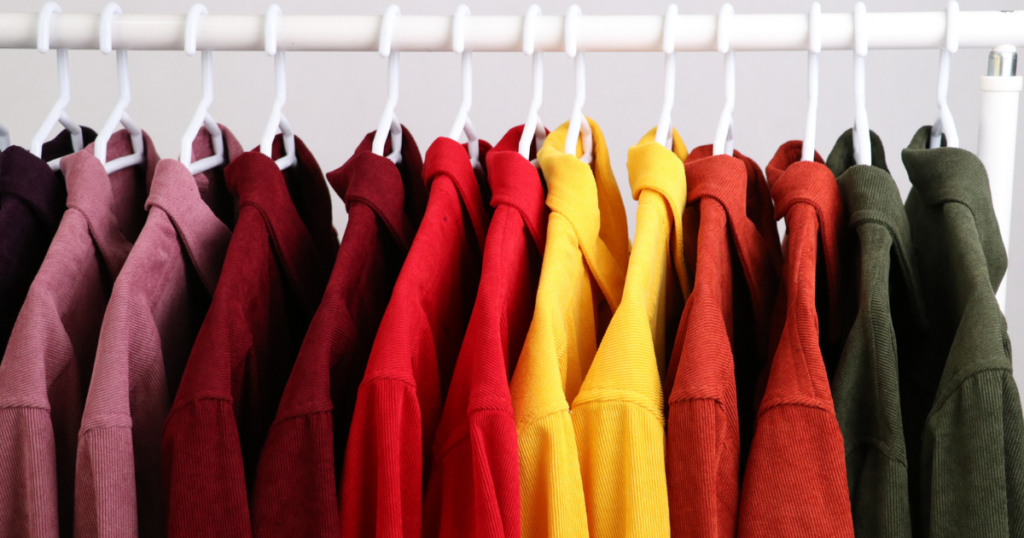
Recommended Alternative for Cleaning Colored Clothing and Fabric:
- Color-Safe Bleach: This is a bleach alternative specifically designed not to harm colors. It’s formulated to help remove stains without stripping the dye from colored fabrics. Always read the label to ensure it’s safe for the particular fabric you’re treating.
- Mild Detergents: Choose a detergent that’s labeled as being gentle or suitable for colors. These detergents are formulated to cleanse effectively without being too harsh on dyes or fabric fibers.
- Stain Removers: For targeted stain treatment, consider using a stain remover that’s safe for colored clothing. Apply as directed and always check an inconspicuous spot first to ensure it doesn’t affect the color.
- Cold Water Washing: Hot water can cause colors to bleed or fade. Opt for cold water when washing colored clothes to help preserve their vibrancy.
- Vinegar and Baking Soda: These natural ingredients can be used to boost detergent power and help remove mild stains from colored clothes without the adverse effects of bleach. A cup of white vinegar or baking soda added to the wash can help cleanse and deodorize.
When cleaning colored fabrics, always read care labels, and if unsure about a cleaning product, do a spot test on a hidden area to ensure it doesn’t damage the color or material.
Carpet
Carpet has to put up with a lot – I mean, we walk on it all the time! Despite the likelihood of stains, you shouldn’t use bleach on carpet in most cases.
Why Bleach Should Never Be Used to Clean Carpet:
- Discoloration: Carpets come in various colors, patterns, and designs. Using bleach on colored or patterned carpets will likely result in noticeable fading or discoloration. Even if the bleach is diluted, there’s a risk that it will bleach out the color in blotches or streaks.
- Damage to Fibers: Bleach is a harsh chemical that can weaken or deteriorate carpet fibers. This can lead to premature wear and tear, making the carpet more susceptible to damage from foot traffic or furniture.
- Residue Problems: Even if thoroughly rinsed, bleach might leave a residue on the carpet, which can attract dirt and grime more quickly, leading to more frequent cleaning needs.
- Potential Health Risks: Residual bleach on carpets can pose health risks, especially in homes with children and pets who are closer to the ground and might ingest or come into direct contact with the carpet.
- Alters Carpet Texture: Some carpets, especially those made from natural fibers, may undergo a change in texture when exposed to bleach, becoming rougher or less plush.
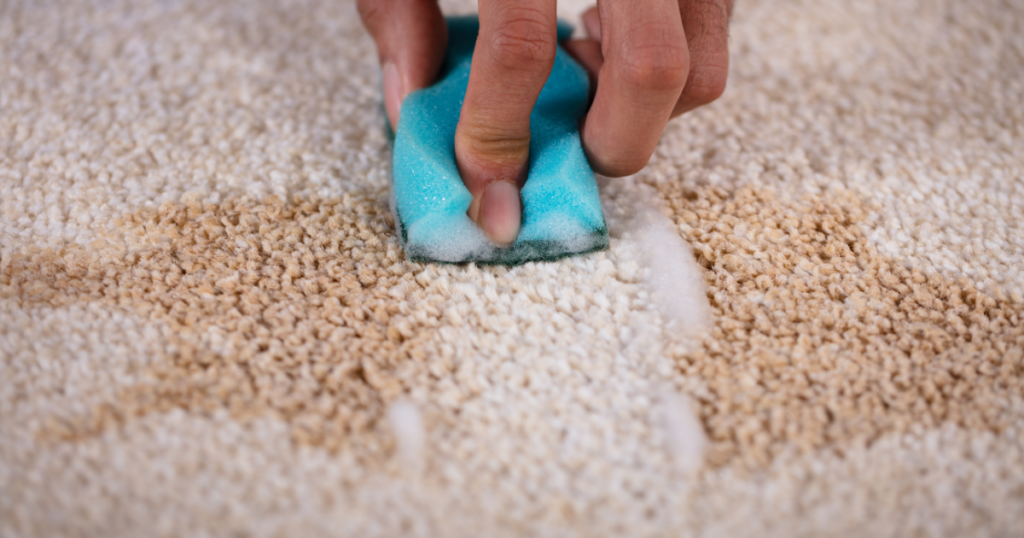
Recommended Alternative for Cleaning Carpet:
- Carpet Cleaning Solutions: There are many carpet-specific cleaning solutions available that are formulated to tackle dirt and stains without harming the carpet’s color or integrity. Always follow the manufacturer’s instructions and test a hidden area first.
- Professional Carpet Cleaning: If stains or dirt are challenging to remove, it might be worth investing in a professional carpet cleaning service. These experts have the equipment and know-how to clean carpets without causing damage.
- DIY Natural Solutions: Mixtures of warm water, white vinegar, and mild dish soap can be effective for spot-cleaning many types of carpet stains. Baking soda can also be sprinkled on stains, allowed to sit, and then vacuumed up.
- Steam Cleaning: A steam cleaner uses hot water vapor to penetrate carpet fibers deeply, breaking up dirt and stains. Make sure to use a carpet-safe detergent or cleaner with the machine if needed.
- Club Soda: For fresh stains, especially those from red wine or juice, club soda can be a useful immediate treatment. Blot (don’t rub) the stain with club soda on a cloth.
- Avoid Over-wetting: Whether you’re using a DIY solution or a purchased carpet cleaner, it’s crucial not to over-wet the carpet. Excess moisture can seep into the carpet pad, leading to mold or mildew problems.
When cleaning carpets, always start by testing any cleaning product or method on a hidden or inconspicuous area first to ensure it doesn’t damage the color or texture. And always read the carpet manufacturer’s care instructions, as some carpets come with specific care guidelines.
Wool
Whenever cleaning wool, it’s essential to be gentle and take the fabric’s delicate nature into account. Always read care labels, and if unsure about a cleaning product or method, test a hidden spot first to ensure it doesn’t damage the wool.
Why Bleach Should Never Be Used on Wool:
- Discoloration: Wool, being a natural fiber, is susceptible to bleach. Using bleach on colored or even natural wool will likely result in discoloration, turning the material yellow or causing uneven blotches.
- Damage to Fibers: Bleach is harsh on wool fibers. It can break down the protein structure of the wool, leading to weakened fibers. This weakens the garment or fabric and makes it prone to tears or wear.
- Alters Texture: Wool has a particular soft and warm texture. Using bleach can alter this, making the wool feel harsh, brittle, or lose its natural loftiness.
- Shrinkage: The harsh nature of bleach can also cause wool to shrink, even if not exposed to heat.
- Residue Problems: Just as with carpets, bleach might leave a residue on wool that can be harmful and affect the feel of the fabric.
- Natural Oil Stripping: Wool contains lanolin, a natural oil that gives it its softness and water-repellent properties. Bleach can strip wool of this natural oil, making it dry and less water-resistant.

Recommended Alternative for Cleaning Wool:
- Mild Detergents: Choose a detergent labeled as suitable for wool or delicate fabrics. These are designed to cleanse effectively without being too harsh on the fibers.
- Cold Water Wash: Always wash wool in cold water, either by hand or on a gentle machine cycle, to prevent shrinkage and maintain the fabric’s integrity.
- Spot Treat with Vinegar or Lemon Juice: For specific stains, a mixture of white vinegar or lemon juice with cold water can be dabbed onto the stain. Always test a hidden spot first.
- Lay Flat to Dry: Never hang wool to dry as it can cause stretching. Instead, lay it flat on a towel, reshaping it as necessary.
- Professional Cleaning: Some wool items, especially suits or structured garments, are better off being dry cleaned. This ensures they maintain their shape and are appropriately cleaned.
- Natural Wool Cleaners: There are wool-specific cleaners available in the market that are formulated to maintain the fabric’s quality and natural oils.
- Avoid Rubbing or Scrubbing: When cleaning, avoid rubbing or scrubbing wool aggressively. This can cause felting, where the fibers mat together and the fabric loses its softness.
Silk
Silk is a delicate and luxurious fabric that requires careful handling to retain its beauty and quality. Always consult the garment’s care label before attempting to clean, and when in doubt, lean towards gentler cleaning methods or professional services.
Why Bleach Should Never Be Used on Silk:
- Discoloration: Silk, a delicate and natural fiber, is highly sensitive to bleach. Even a small amount can lead to significant fading or uneven blotches, ruining the fabric’s appearance.
- Damage to Fibers: Bleach can degrade the protein structure that constitutes silk. This leads to the weakening of the material, making it susceptible to tears, fraying, or wear.
- Loss of Sheen: One of silk’s most prized characteristics is its natural sheen. Bleach can dull this sheen, stripping the fabric of its luxurious look.
- Alters Texture: The smooth, soft feel of silk can be compromised when exposed to bleach, making the material feel rough or brittle.
- Residue Problems: Any remaining bleach residue on silk can be harmful, further damaging the fabric and potentially causing skin irritations if worn.
- Weakens Structure: Even if the silk doesn’t show immediate signs of damage, bleach can compromise its structural integrity, leading to issues down the line.
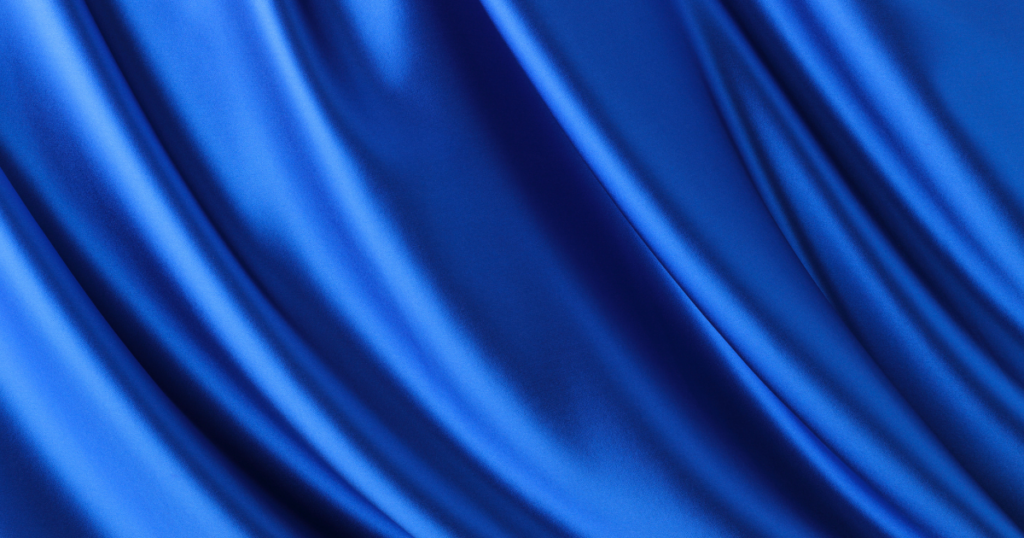
Recommended Alternative for Cleaning Silk:
- Mild Detergents: Opt for detergents or cleaners specifically designed for silk or delicate fabrics. These formulations cleanse without harming the silk fibers.
- Hand Wash with Cold Water: When washing silk, it’s typically best to hand wash using cold water to maintain the fabric’s quality and prevent shrinkage or distortion.
- Spot Treat Carefully: For specific stains, a mixture of lukewarm water with a few drops of mild detergent can be used. Dab gently, avoiding rubbing or scrubbing.
- Lay Flat to Dry: Silk should be laid flat to dry, away from direct sunlight which can fade its color. Never wring out silk to dry, as this can distort its shape.
- Avoid Direct Heat: Never use a hot iron directly on silk. If you need to iron silk, place a cloth between the iron and the fabric and use a low heat setting.
- Professional Cleaning: Many silk garments recommend professional dry cleaning to ensure the material is treated appropriately and maintains its quality.
- Natural Solutions: A mixture of cold water and white vinegar can help to retain the sheen and softness of silk. However, always spot test before treating the entire garment.
Wooden Surfaces
When it comes to wooden surfaces, gentle is the way to go. Natural methods or specialized wood cleaners are best, ensuring the longevity and beauty of the wood. Always test any cleaning solution on a hidden area first to ensure it doesn’t damage the wood or its finish.
Why Bleach Should Never Be Used on Wooden Surfaces:
- Discoloration: Wood is porous, and bleach can discolor the surface, leading to lightened spots or an uneven appearance. This is especially true for woods with a natural finish or lightly stained woods.
- Drying and Weakening: Bleach can excessively dry out wooden surfaces, leading to cracking, splintering, or warping over time.
- Removal of Natural Oils: Wood often contains natural oils that give it a rich appearance and help protect it. Bleach can strip these oils, making the wood look dull and reducing its natural protection.
- Residue Issues: Bleach might leave a residue on wood, which can be difficult to remove and could impact any subsequent treatments, stains, or finishes.
- Hazard to Finishes: If the wood has been sealed, varnished, or painted, bleach can corrode or damage these finishes, leading to peeling, bubbling, or discoloration.
- Health Concerns: The porous nature of wood means that bleach can seep in and linger, potentially releasing fumes long after you think it’s been cleaned off. This can pose respiratory or skin contact risks.
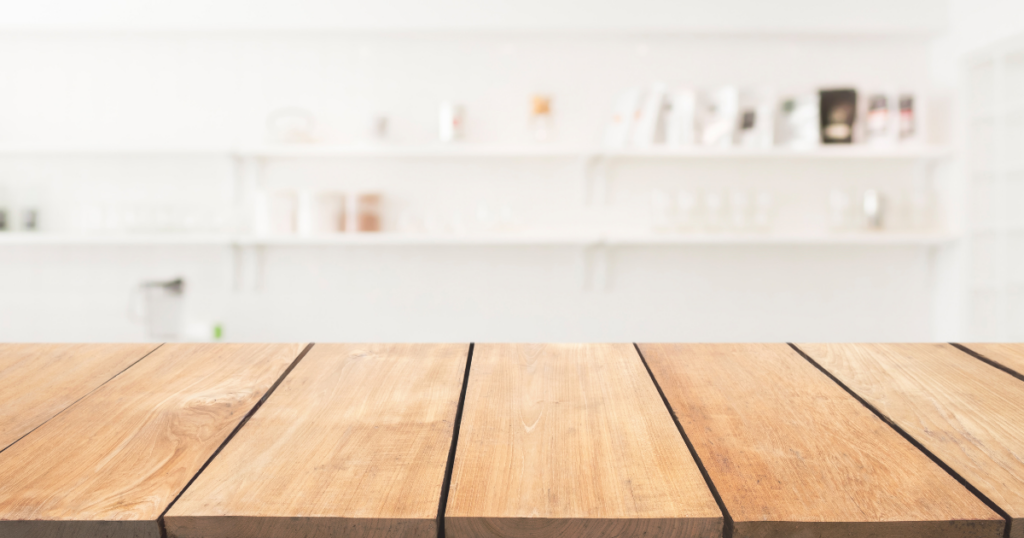
Recommended Alternative for Cleaning Wooden Surfaces:
- Mild Soap and Water: A mixture of mild dish soap and water is often sufficient for cleaning wooden surfaces. Remember to wring out the cloth well so it’s damp, not wet, to avoid water damage.
- Wood Cleaners and Polishes: There are specialized cleaners available specifically designed for wood, which clean while also nourishing the wood and maintaining its shine.
- White Vinegar and Olive Oil: A mixture of equal parts white vinegar and olive oil can not only clean but also help to bring out the shine in wood.
- Beeswax Polish: For an added layer of protection and shine, consider using a beeswax-based polish after cleaning.
- Dusting: Regularly dusting wooden surfaces with a soft cloth can prevent the buildup of grime, making deeper cleaning sessions less frequent and easier when they are necessary.
- Microfiber Cloths: These are excellent for picking up dust and dirt without scratching or damaging the wood’s surface.
- Avoid Excess Moisture: Always ensure that cloths or mops are well-wrung out before using them on wood, and dry the surface promptly. Prolonged moisture exposure can damage wood.
Stainless Steel Appliances
When cleaning stainless steel, it’s vital to remember that the material maintains its lustrous appearance and rust-resistant properties due to a protective film on its surface. Harsh chemicals like bleach can compromise this protective layer.
Thus, gentle cleaning methods are preferred to maintain the look and longevity of your stainless steel appliances.
Why Bleach Should Never Be Used on Stainless Steel Appliances:
- Corrosion: The primary concern with using bleach on stainless steel is that it can corrode the surface. While stainless steel is resistant to rust, chlorine in bleach can react with the metal and damage its protective layer, making it susceptible to rust and pitting.
- Discoloration: Prolonged contact with bleach can lead to discoloration or staining of the stainless steel surface.
- Streaks and Spots: Bleach can leave streaks, spots, or a filmy residue on stainless steel, diminishing its shine and smooth appearance.
- Residue Concerns: Any bleach residues left on the surface can react over time, leading to potential damage or discoloration later on, even if it looks clean initially.
- Safety Concerns: If not rinsed thoroughly, bleach residue can come in contact with food items, especially in kitchen appliances, leading to health risks.
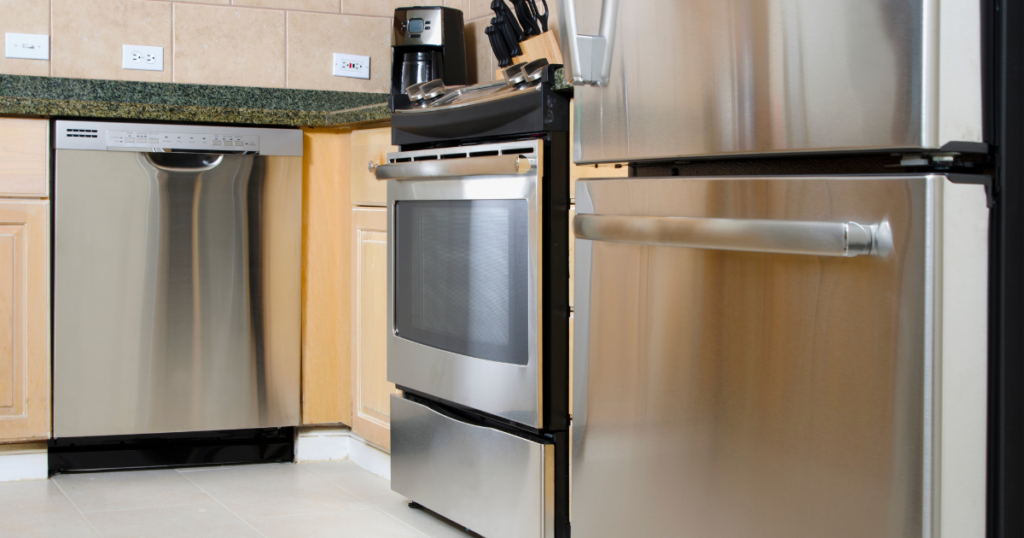
Recommended Alternative for Cleaning Stainless Steel Appliances:
- Warm Water and Mild Soap: For regular cleaning, a soft cloth dampened with warm water and a drop of mild dish soap is often enough to clean stainless steel appliances.
- White Vinegar and Olive Oil: White vinegar is great for removing fingerprints and smudges. Apply using a cloth and follow it up with olive oil (or another mineral oil) for shining. Always wipe in the direction of the grain.
- Specialized Cleaners: There are stainless steel cleaners and polishes available that can remove tough stains, smudges, and help to restore the appliance’s shine.
- Baking Soda for Tough Stains: For hard-to-remove stains, a paste of baking soda and water can be applied gently with a soft cloth or sponge. Rinse thoroughly after use.
- Microfiber Cloths: These cloths are gentle on surfaces and won’t scratch the steel. They’re also effective at removing smudges and fingerprints without the need for chemicals.
- Avoid Abrasives: Always avoid using abrasive sponges, steel wool, or rough cloths, as they can scratch the surface of the stainless steel.
- Regular Maintenance: Wipe down your stainless steel appliances regularly to prevent buildup of dirt, grime, or fingerprints. This regular maintenance makes deeper cleaning sessions less frequent and more effective when they are necessary.
Natural Stone Countertops (Granite, Marble, etc.)
Natural stone countertops, with their unique patterns and colors, are a significant investment and a centerpiece in many homes. So, you don’t want to mess them up with bleach!
Why Bleach Should Never Be Used on Natural Stone Countertops (Granite, Marble, etc.):
- Erosion and Pitting: Many natural stones are sensitive to acidic and alkaline substances. Bleach is alkaline and can lead to surface erosion or pitting, especially on softer stones like marble.
- Discoloration: Bleach can lead to discoloration or uneven patches on the stone’s surface, altering its natural beauty.
- Stripping of Sealants: Most natural stone countertops are sealed to protect them from stains and damage. Bleach can strip away these sealants, leaving the stone vulnerable to staining and other damages.
- Residue Issues: Any bleach residue that remains can continue to damage the stone over time, especially if not thoroughly rinsed off.
- Natural Beauty Diminishment: The unique veining and patterns in natural stone can be dulled or discolored with bleach, diminishing the stone’s natural beauty and shine.
- Safety Concerns: Especially in kitchen environments, bleach residues on countertops can pose risks if they come into contact with food.
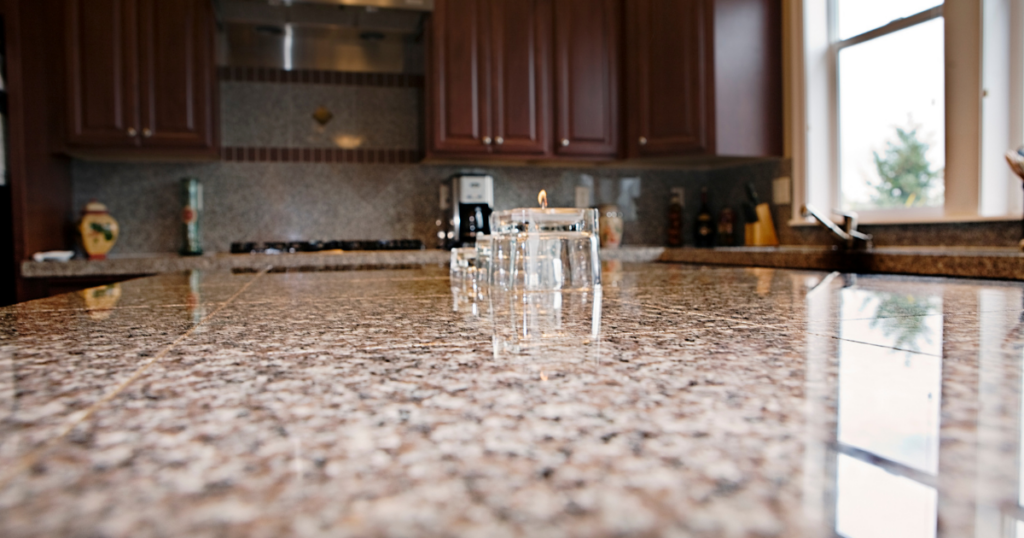
Recommended Alternative for Cleaning Natural Stone Countertops:
- Mild Soap and Warm Water: A soft cloth or sponge dampened with warm water and a drop of mild dish soap is usually enough for everyday cleaning of natural stone countertops.
- Stone-Specific Cleaners: There are cleaners available on the market specifically formulated for natural stone. These are pH-balanced to ensure they won’t harm the stone.
- Hydrogen Peroxide for Stains (on light-colored stones): For stubborn stains on light-colored stones, you can use a cloth soaked in hydrogen peroxide. However, always test a hidden spot first.
- Cornstarch for Grease Stains: For grease-related stains on granite, sprinkling cornstarch and letting it sit for a day before wiping can help absorb the grease.
- Avoid Acidic Cleaners: Natural stones, especially marble, are sensitive to acids. Avoid using vinegar, lemon, or other acidic cleaners.
- Wipe Spills Promptly: To prevent potential staining or damage, always wipe up spills on natural stone countertops immediately, especially acidic substances like tomato sauce or wine.
- Regular Sealing: Depending on the stone and usage, periodically sealing your countertop can help protect it from stains and damage. Always refer to the manufacturer’s recommendations or consult with a stone professional.
- Use Soft Cloths or Sponges: Avoid abrasive materials that can scratch or damage the surface of the stone.
Leather and Suede Items
Leather and suede are luxurious and delicate materials. Proper care ensures they look good and have a long lifespan. Always do a spot test with any cleaning solution, even those recommended for leather or suede, to ensure it doesn’t damage or discolor the material.
If in doubt, especially for valuable or deeply stained items, consult with a professional leather or suede cleaner.
Why Bleach Should Never Be Used on Leather and Suede:
- Discoloration and Damage: Both leather and suede are natural materials, and bleach can cause severe discoloration, often leaving a permanent white spot or a faded area that stands out.
- Drying Out: Leather has natural oils that give it flexibility and a luxurious texture. Bleach can strip these oils, leading to dryness, brittleness, and eventual cracking.
- Altering Texture: Suede has a soft, napped finish. Bleach can ruin this delicate texture, making it stiff or uneven.
- Degradation of Material: Over time, bleach can weaken the structure of leather and suede, making them susceptible to tears or wear.
- Residue Issues: Bleach may leave a residue, which can further damage the material and potentially cause skin irritations when worn.
- Safety Concerns: Especially for items like leather or suede gloves or hats, any residual bleach can come in contact with skin, leading to potential reactions.

Recommended Alternative for Cleaning Leather:
- Mild Soap and Water: For smooth leather, a mixture of mild soap and water, applied with a soft cloth, can remove most surface dirt.
- Leather Cleaners and Conditioners: These products are specially formulated to clean leather without stripping its natural oils. Conditioners help to restore moisture and maintain the leather’s suppleness.
- Avoiding Water: For minor soiling on leather, sometimes all you need is a dry cloth. Excessive water can stain leather or alter its shape, especially on items like shoes.
- Wipe Spills Promptly: To prevent potential staining, always wipe up spills on leather immediately.
Recommended Alternative for Cleaning Suede:
- Suede Brush: A soft-bristled suede brush can help remove light soiling and restore the nap of the suede.
- White Vinegar or Rubbing Alcohol: For tougher spots or stains, dabbing a little white vinegar or rubbing alcohol with a soft cloth can help. Always test a hidden spot first.
- Avoiding Water: Water can stain suede or cause discoloration. If suede gets wet, allow it to dry naturally, away from direct heat sources.
- Pencil Eraser: For light marks, a pencil eraser can be gently used to lift away the stain.
- Cornstarch or Talcum Powder: For oily stains, sprinkle a little cornstarch or talcum powder on the stain, let it sit for a few hours, and then brush away with a suede brush.
Acrylic Tubs and Showers
It’s essential to regularly maintain and clean acrylic tubs and showers to preserve their shine and clarity.
When in doubt about a cleaning product or method, it’s always a good idea to test a small, inconspicuous area first or refer to the manufacturer’s care and maintenance guidelines.
Why Bleach Should Never Be Used on Acrylic Tubs and Showers:
- Surface Damage: Bleach can cause scratching or etching on the smooth surface of acrylic tubs and showers. Once damaged, these scratches can trap dirt and become breeding grounds for bacteria.
- Discoloration: Prolonged or repeated use of bleach can lead to discoloration, turning the clear acrylic to a yellow or cloudy hue.
- Material Degradation: Acrylic is a type of plastic, and bleach can weaken its structure over time, making it prone to cracks or breaks.
- Residue Issues: Bleach residue, if not rinsed thoroughly, can continue to damage the acrylic surface. Moreover, this residue can react with other cleaning products used later on.
- Harmful Fumes: Especially in the confined space of a bathroom without adequate ventilation, the fumes from bleach can be overwhelming and harmful.
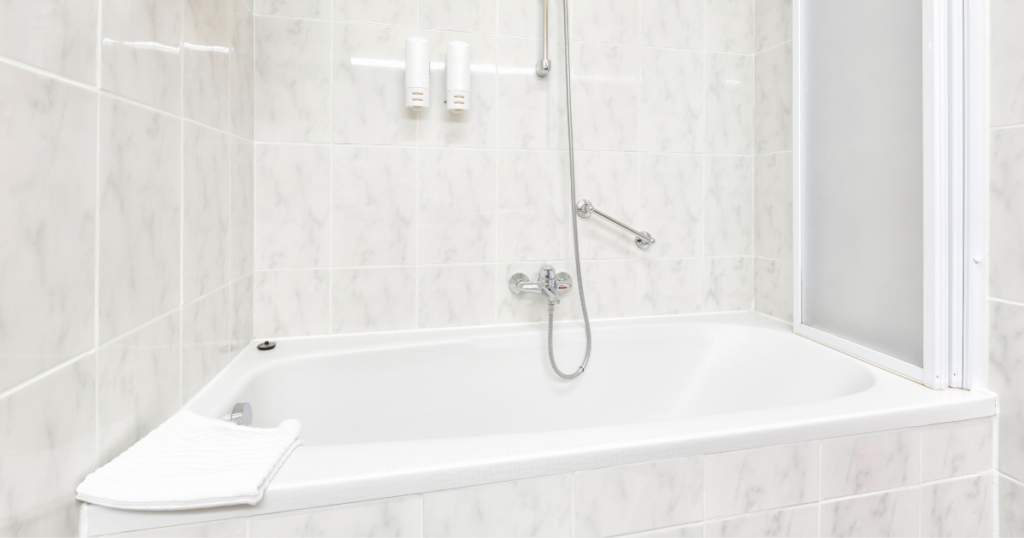
Recommended Alternatives for Cleaning Acrylic Tubs and Showers:
- Mild Soap and Warm Water: This is often enough for everyday cleaning. Use a soft cloth or non-abrasive sponge to apply.
- Vinegar and Water Solution: Mix equal parts of white vinegar and water in a spray bottle. Spray on the acrylic surface, let it sit for a few minutes, then rinse with cold water and dry with a soft cloth.
- Baking Soda: For tougher stains, make a paste with baking soda and a little water. Gently rub the stain with the paste using a soft cloth, then rinse thoroughly.
- Commercial Acrylic Cleaners: There are cleaners available specifically designed for acrylic tubs and showers. These are formulated to be gentle on the acrylic while effectively removing soap scum and stains.
- Preventative Care: Use a squeegee after each shower to remove water and prevent hard water stains and soap scum build-up. Additionally, ensuring good ventilation in the bathroom can help reduce mold and mildew growth.
- Avoid Abrasives: Never use abrasive scrubbers like steel wool or scouring pads on acrylic surfaces as they can scratch and damage the material.
Aluminum and Copper
For both aluminum and copper, it’s essential to dry the items thoroughly after cleaning to prevent water spots and further tarnishing.
Additionally, always test a small, inconspicuous spot before applying any cleaning solution to the entire item, especially for antiques or valuable pieces.
Why Bleach Should Never Be Used on Aluminum:
- Corrosion: Bleach can react with aluminum, leading to corrosion and weakening the material. Over time, this can cause pits or holes to form in the aluminum.
- Discoloration: Bleach can cause dark spots or discoloration on aluminum surfaces.
- Degradation of Protective Layer: Some aluminum items have a protective oxide layer or are anodized to prevent corrosion. Bleach can degrade this protective layer, making the aluminum vulnerable to environmental factors.
- Gas Formation: When bleach reacts with aluminum, it can produce hydrogen gas, which is a potential explosion risk in enclosed spaces.
Why Bleach Should Never Be Used on Copper:
- Tarnishing: Bleach accelerates the tarnishing process in copper, turning it black or greenish much faster than it would naturally.
- Structural Damage: Continued exposure to bleach can weaken copper, making it brittle and prone to cracking or breaking.
- Residue Issues: Bleach residues can continue to react with copper even after cleaning, leading to long-term damage.
- Altered Finish: Many copper items have a polished or specific finish, which bleach can dull or alter.
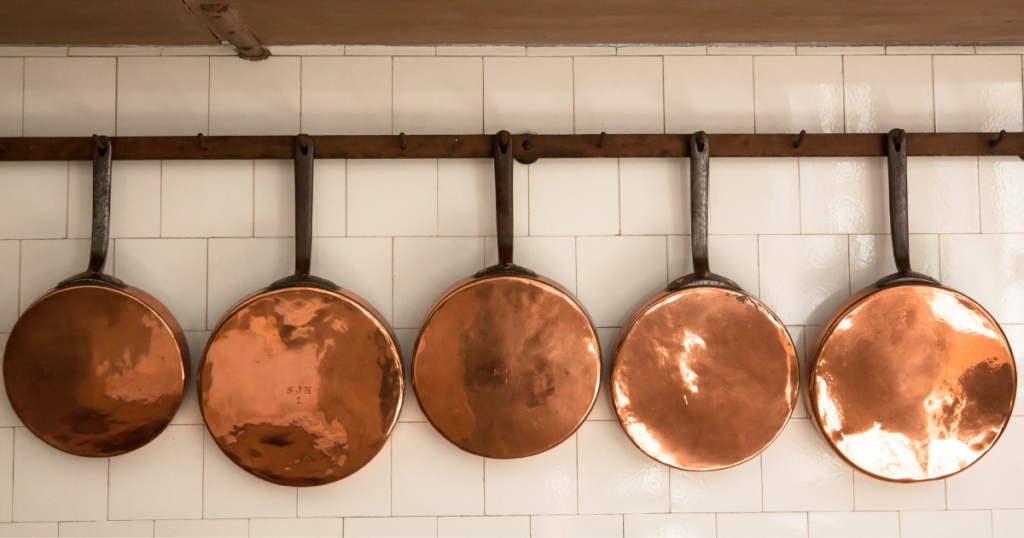
Recommended Alternatives for Cleaning Aluminum:
- Soap and Water: Mild dish soap and water, applied with a soft cloth or sponge, are often effective for general cleaning of aluminum.
- White Vinegar and Water: A mixture of equal parts white vinegar and water can be effective for cleaning and shining aluminum surfaces.
- Cream of Tartar: For tougher stains on aluminum, a paste made of cream of tartar and water can be applied, left to sit for a few minutes, and then rinsed off.
- Aluminum Cleaners: There are commercial cleaners specifically designed for aluminum available in the market.
Recommended Alternatives for Cleaning Copper:
- Lemon and Salt: A slice of lemon sprinkled with salt can be used to scrub the copper. The acidic nature of the lemon combined with the abrasive salt can help to clean and shine the copper. Rinse and polish afterward.
- Vinegar and Salt: Like the lemon method, vinegar can be used in place of the lemon. Create a paste with vinegar and salt, apply to the copper, scrub, and then rinse.
- Ketchup: The acidity in ketchup can help remove tarnish from copper. Apply a thin layer, let it sit for a few minutes, and then rinse.
- Copper Cleaners: Commercial copper cleaners are available and can be used for stubborn tarnish or when a bright shine is desired.
Rubber and Some Plastics
For both rubber and plastics, it’s crucial to understand the specific type or formulation you’re working with, as this can affect its resistance to various cleaning agents.
Always check manufacturer guidelines or conduct a spot test before applying any cleaning product to a larger area.
Why Bleach Should Never Be Used on Rubber:
- Material Breakdown: Bleach can cause rubber to become brittle over time, leading to cracks and degradation.
- Discoloration: The rubber can become discolored when exposed to bleach, often turning white or pale.
- Loss of Elasticity: One of rubber’s key characteristics is its elasticity. Bleach exposure can cause rubber to lose this elasticity, making it less flexible and more prone to breaking.
- Surface Damage: Some rubber items may have a specific finish or texture that bleach can alter or damage.
- Odor: Bleach can leave behind a persistent odor on rubber, which can be hard to eliminate.
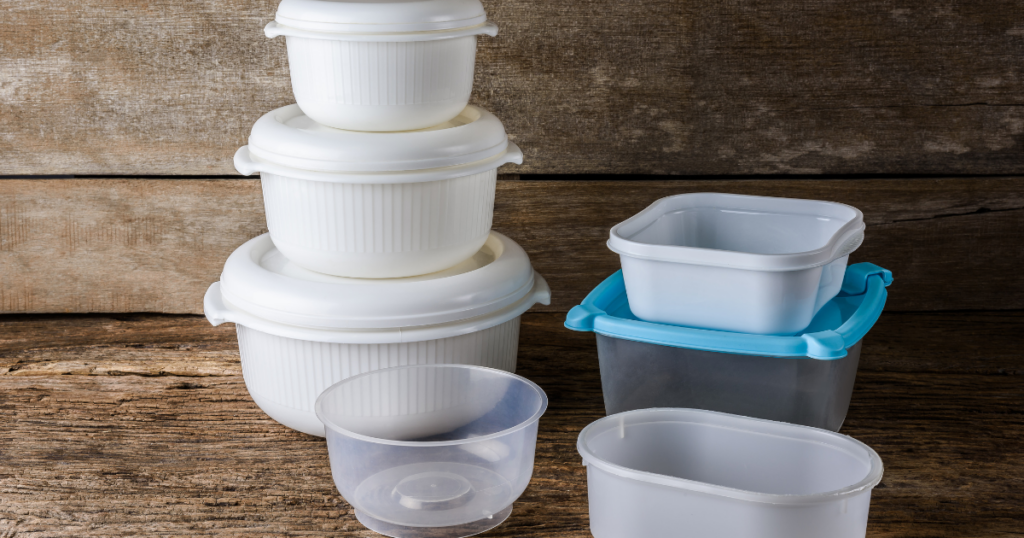
Why Bleach Should Never Be Used on Some Plastics:
- Chemical Reaction: Some plastics can react with bleach, leading to cloudiness, warping, or other structural changes.
- Discoloration: Plastics exposed to bleach can discolor, turning yellow or becoming cloudy.
- Surface Breakdown: Bleach can make certain plastics brittle, increasing the risk of cracks or breaks.
- Residue Issues: Residual bleach left on plastics can continue to degrade the material over time or become a risk when the item is used for food storage or other sensitive purposes.
- Alteration of Properties: Certain plastics have specific properties, like being food-safe or UV-resistant. Bleach can alter these properties, making the plastic unsafe or less effective for its intended use.
Recommended Alternatives for Cleaning Rubber:
- Mild Soap and Water: This is often enough for general cleaning of rubber items. Use a soft brush or cloth for scrubbing if necessary.
- White Vinegar: For disinfection or deeper cleaning, white vinegar can be effective without damaging the rubber.
- Rubbing Alcohol: It can be used for spot cleaning or disinfecting rubber surfaces.
- Commercial Rubber Cleaners: Some cleaners are formulated specifically for rubber and can be effective, especially for larger items like rubber flooring.
Recommended Alternatives for Cleaning Plastics:
- Mild Soap and Warm Water: Suitable for most plastics, especially for everyday cleaning.
- White Vinegar and Water Solution: Effective for cleaning and disinfecting many plastic surfaces.
- Baking Soda: For tougher stains on plastics, a paste made from baking soda and water can be used. Apply, scrub gently with a soft brush or cloth, then rinse.
- Commercial Plastic Cleaners: There are plastic cleaning products available that are designed to clean without causing damage.
- Avoid Abrasives: To prevent scratching or dulling the surface, avoid using abrasive pads or brushes on plastics.
Septic Systems
Always prioritize the health of your septic system to prevent costly repairs and potential environmental damage.
Remember that while small, diluted amounts of bleach might not cause immediate harm to your septic system, the cumulative effects of consistent bleach use can result in long-term damage.
Why Bleach Should Never Be Used Excessively in Septic Systems:
- Killing Beneficial Bacteria: One of the primary concerns of using bleach in septic systems is that it can kill the beneficial bacteria responsible for breaking down waste. A functioning septic system relies heavily on these bacteria to operate effectively.
- Potential for Groundwater Contamination: If used excessively, bleach can leach into the ground, potentially contaminating groundwater.
- Disruption of Septic Process: Over time, the repeated use of bleach can disrupt the septic process, leading to solid waste build-up and possible blockages.
- Damage to Tank Components: Bleach can corrode certain components of the septic tank, leading to leaks or other damage.
- Environmental Concerns: Bleach is a chemical that, when introduced to the environment in large quantities, can harm plant and aquatic life.
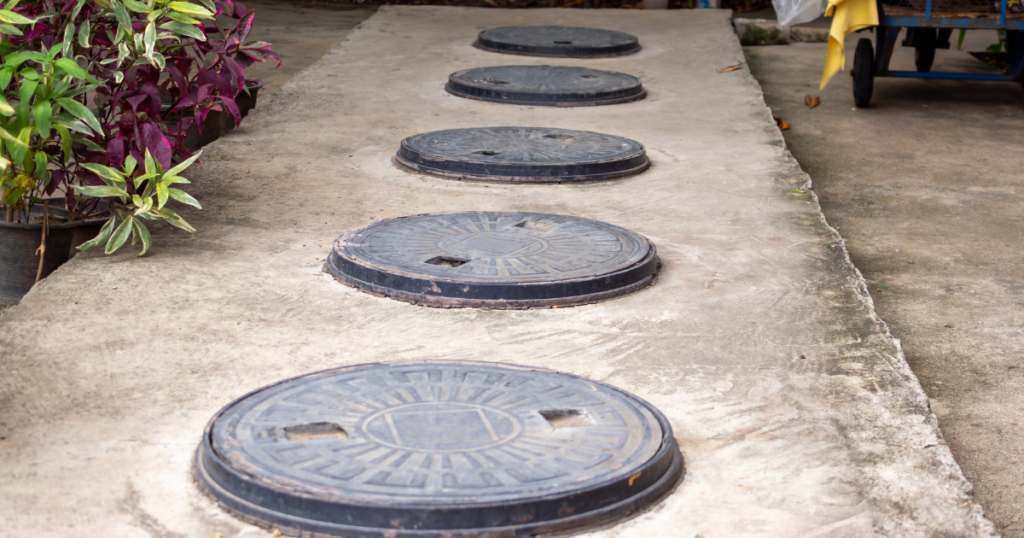
Recommended Alternatives and Best Practices for Septic System Owners:
- Use Septic-Safe Cleaners: There are cleaning products specifically labeled as safe for septic systems. These products are designed to be effective cleaners without harming the bacterial ecosystem within the tank.
- Limit Bleach Usage: If bleach must be used, do so sparingly and dilute it with water. It’s also beneficial to stagger heavy uses, giving your septic system time to recover.
- Natural Cleaning Alternatives: Baking soda, vinegar, and lemon juice can often serve as effective and environmentally friendly cleaning alternatives.
- Regular Maintenance: Ensure your septic system undergoes regular inspections and pumping as necessary. This helps catch any potential issues early and keeps your system running efficiently.
- Educate Household Members: Make sure everyone in the household understands the importance of septic system care and the potential harm certain products can cause.
- Avoid Other Harmful Products: Apart from bleach, avoid flushing or pouring down the drain any other harmful chemicals, non-biodegradable items, or excessive amounts of fats and oils.
Let Us Know How We’re Doing!
Did this expertly prepared resource answer your question?
Do you have another question about home maintenance, home improvement projects, home appliance repair, or something else?
Get more information, send in questions and keep the discussion going by contacting the I’ll Just Fix It Myself company customer service team at at 1-800-928-1490 or Email us at [email protected]
